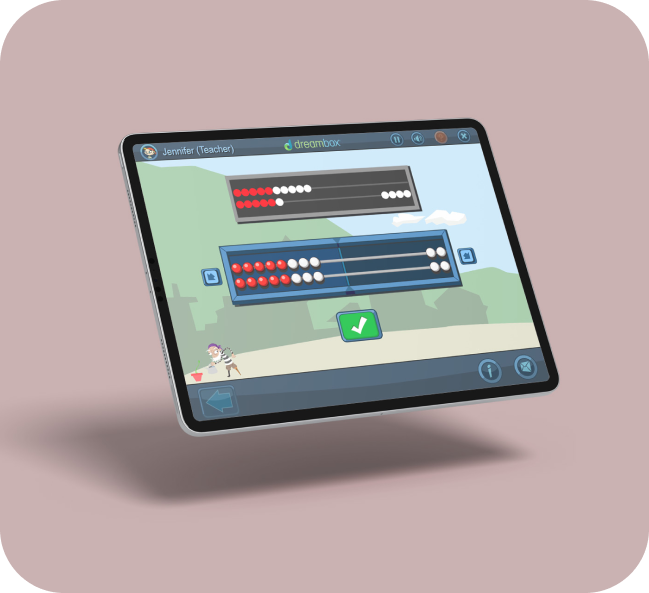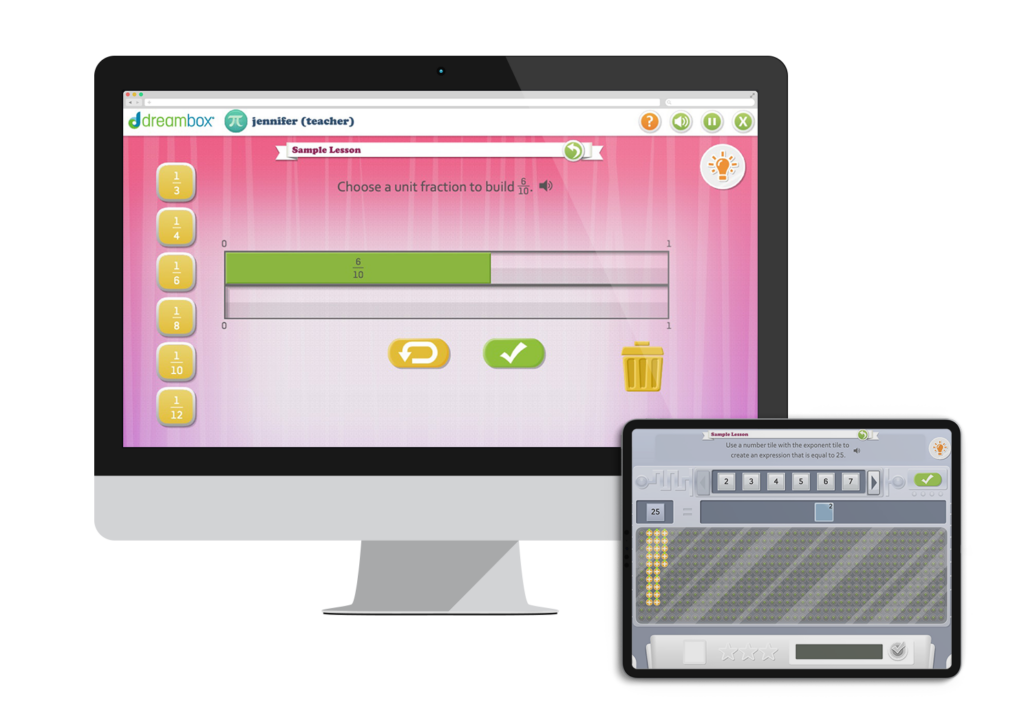
Boost seventh grade math
skills with DreamBox
Discover an interactive math program your seventh grader will love.
DreamBox Math is here to help your seventh grader find success, with interactive, fun lessons and a proven curriculum. With DreamBox Math, your seventh grader will boost their math skills and their confidence.
Boost seventh grade math skills with DreamBox
Discover an interactive math program your seventh grader will love.
DreamBox Math is here to help your seventh grader find success, with interactive, fun lessons and a proven curriculum. With DreamBox Math, your seventh grader will boost their math skills and their confidence.

Customized learning experience
ADAPTIVE LESSONS
Every seventh grader learns differently, and DreamBox adjusts to meet their unique interests and learning style. Whether they’re advancing rapidly or require more guidance, DreamBox provides a personalized path that builds confidence and ensures steady progress.
Start for free with ease
SIMPLE SIGN-UP PROCESS
It’s simple to begin your child’s DreamBox journey! Take advantage of a free 14-day trial and discover how this innovative program can support your seventh grader in math.


Strengthen key skills
TARGETED LESSON FOCUS
Is your seventh grader excelling in solving equations but finding geometry challenging? DreamBox’s assignment tool lets you identify their progress and assign lessons tailored to their needs. By providing targeted practice to help them overcome challenges and develop their strengths, DreamBox is the perfect springboard for your child’s growth.
Start your free trial
See how DreamBox can help your seventh grader with math by signing up for a free trial today.
Parents and teachers love DreamBox
Benefits of DreamBox for seventh grade math
Over half of seventh graders in the US are falling behind in math (CRPE). DreamBox helps students get back on track by making learning enjoyable for seventh graders while giving parents and educators tools to track progress.
Tailored for Young Learners
DreamBox captivates students with interactive lessons, engaging characters, and stimulating activities designed to maintain their interest.
Continuous Progress Monitoring
With DreamBox’s constant tracking, you won’t need periodic placement tests. Get real-time insights into your child’s growth, progress, and accomplishments.
FUNctional Screen Time
DreamBox turns screen time into an opportunity for meaningful learning by blending fun and education in each lesson.
Individualized Lesson Plans
As your seventh grader advances, DreamBox adjusts to their evolving needs, ensuring lessons are perfectly suited to their current level.
Trackable Success
DreamBox delivers measurable growth. Students who spend just 30–60 minutes per week on DreamBox typically gain 1.5 grade levels of improvement by the end of the school year.
Proven Results
DreamBox Learning is the only dual-discipline program rated STRONG by Evidence for ESSA, demonstrating efficacy across all achievement levels and learning environments.
Tailored for young learners
DreamBox captivates students with interactive lessons, engaging characters, and stimulating activities designed to maintain their interest.
Continuous progress monitoring
With DreamBox’s constant tracking, you won’t need periodic placement tests. Get real-time insights into your child’s growth, progress, and accomplishments.
FUNctional screen time
DreamBox turns screen time into an opportunity for meaningful learning by blending fun and education in each lesson.
Individualized lesson plans
As your seventh grader advances, DreamBox adjusts to their evolving needs, ensuring lessons are perfectly suited to their current level.
Trackable success
DreamBox delivers measurable growth. Students who spend just 30–60 minutes per week on DreamBox typically gain 1.5 grade levels of improvement by the end of the school year.
Proven results
Seventh grade curriculum alignment
Our seventh grade online math practice tool and resources are aligned with educational math standards. By the end of the school year, your seventh grader should feel confident with these key math concepts:
- Multiplication and Division
- Multiplying Integers
- Dividing Integers
- Multiply & Divide Integers: Automaticity I
- Multiply & Divide Integers: Automaticity II
- Geometry
- Construction & Measuring Polygons III
- Angles
- The Coordinate Plane with Decimals 2
- Solving for the Volume and Surface Area of Prisms & Pyramids
- Area and Circumference of Circles
- Matching 2D Shape Slides to their 3D Solids
- Expressions and Equations
- Absolute Value
- Identifying Variables
- Integer Operations 1
- Integer Operations 2
- Variable Expressions Involving Integers
- Variable Expressions with Distribution
- Scaling by Powers of Ten
- Two-Step Equations & Inequalities
- Rewrite Expressions 3
- Rewrite Expressions 4
- Rewrite Expressions 5
- Ratios and Proportions
- Calculating Percentages
- Ratios in Context: Measurement
- Ratios & Multiplication
- Ratios & Division with Fractions
- Addition & Subtraction
- Add & Subtract Integers: Automaticity I
- Add & Subtract Integers: Automaticity II
Easy access anytime, anywhere
DreamBox is available on computers, laptops, and iPads through an internet browser and via our iPad app. Whether at home, in the car, or at the park, your first grader can keep practicing math wherever they are. At this time, DreamBox Math is not available on smartphones, Android tablets, or eReaders.

FAQs
Yes! DreamBox offers multiple grade levels and family plan options, making supporting your child’s math learning easier than ever.
DreamBox Math helps seventh graders with math by analyzing how they approach problems in each lesson. It adjusts activities to match their individual learning style and needs, ensuring they’re consistently challenged. DreamBox monitors their progress as your student learns and grows and refines lessons to support their development. This personalized approach creates a unique learning journey tailored just for them!
Support your seventh grader by setting learning goals together! Kids love seeing their progress on DreamBox, which keeps them engaged and motivated. Start with small milestones based on lessons and then advance to focusing on mastering specific skills.
Celebrating their efforts and achievements builds their confidence. Track their progress with the DreamBox Family Dashboard and celebrate their achievements. You can even print certificates to commemorate milestones and celebrate their success!
Seventh grade math resources
Welcome to 7th grade! You’ve successfully navigated the challenges of elementary school and have grown significantly in your math journey. Now, it’s time to build on those skills and explore new concepts to prepare for the exciting adventures of middle school. Keep pushing forward, stay curious, and enjoy the ride!
Find other grades
If you’ve ever wondered how to help your child with math homework or what they should know by the end of fifth grade, these elementary math resources are for you.
Choose a grade level below to browse math skills and objectives by grade.
It’s time to build on what we’ve learnt so far and develop mathematical fluency.
Level up number knowledge with the introduction of multiplication, division and fractions.
Classifying, analysing and problem-solving: we’re applying all our skills here!
Understanding is extended even further across number, measurement and geometry.
Meet ratio, rational numbers and equations – this is where we explore statistical thinking.
Children learn more advanced topics like pre-algebra and investigate complex statistics and probability.
Introduce problems involving shape, scale drawings, population samples and more.

